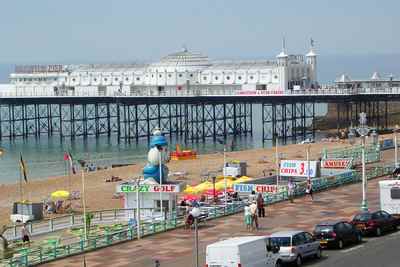- MENU
- HOME
- SEARCH
- WORLD
- MAIN
- AFRICA
- ASIA
- BALKANS
- EUROPE
- LATIN AMERICA
- MIDDLE EAST
- United Kingdom
- United States
- Argentina
- Australia
- Austria
- Benelux
- Brazil
- Canada
- China
- France
- Germany
- Greece
- Hungary
- India
- Indonesia
- Ireland
- Israel
- Italy
- Japan
- Korea
- Mexico
- New Zealand
- Pakistan
- Philippines
- Poland
- Russia
- South Africa
- Spain
- Taiwan
- Turkey
- USA
- BUSINESS
- WEALTH
- STOCKS
- TECH
- HEALTH
- LIFESTYLE
- ENTERTAINMENT
- SPORTS
- RSS
- iHaveNet.com: Travel
By Rick Steves

Brighton Pier
Brighton is South England's fun city and the destination for students, bohemians and blue-collar Londoners looking to go "on holiday." In 1840, a train connected the city to London, making the beach accessible to the masses for the first time. Since then, Brighton has become "London by the Sea." Whether wind, rain, or shine, it's where people come for a good time -- and a fine toffee apple. And though the town has grown a little shabby, Brighton still knows how to crank out the fun.
The Royal Pavilion, once the holiday residence of King George IV, is one of Brighton's most eye-catching landmarks. And a visit here comes with a little gossip. The decadent and trendsetting king was well-known for his scandalous "secret" marriage to Catholic widow Mrs. Fitzherbert. He loved to vacation with her here by the sea and host glamorous dinner parties. Along with Mrs. Fitzherbert, music was one of his passions. In the music room, the king's own band serenaded guests under Chinese-inspired decor. The king's other passion: food. The table in the banquet room is set for the dessert course. Picture England's elite nibbling crumpets under the one-ton chandelier, with its dragons exhaling light through lotus-shaped shades.
The Palace Pier juts playfully into the sea. Glittering and shiny with amusement-park rides and carnival games, it's the place to go to buy tacky souvenirs, have your fortune told, and eat "candy floss" (cotton candy). The pier's pavilion is a 19th-century gem. Tune out the carnival ambience for a moment and imagine yourself as a Victorian Londoner out on holiday, seeing brilliant electric lights for the first time.
The big news in Brighton for the next year is the building of a beachfront observation tower designed by the architects of the London Eye. Scheduled for possible completion in 2010, the i360 includes a doughnut-like elevator that will lift tourists to a bird's-eye view over the town.
Then, of course, there's the beach. While Brighton isn't likely to be confused with Spain's Costa del Sol, a stroll along its gravelly beach offers a pleasant opportunity to get your feet wet. And striped beach chairs along the promenade are free for loungers.
The countryside around Brighton offers less ticky-tacky and more pristine nature. Stretching east of Brighton is a coastline fringed with broad, rolling green downs, or hills. This area, known as the South Downs Way, runs for 100 miles along the chalk hills of England's south coast, and in April 2010, it will officially become the country's ninth national park. Beachy Head is a highlight of the South Downs Way. Its white cliffs are often mistaken for Dover's. Really, it's the same chalk, just farther west along the coast.
Locals consider these trails a birthright. About once a year English hiking clubs sponsor what they call a "Mass Trespass," when walkers throughout the land use every trail and cross every fence to assert their public right of way. "Kissing gates" allow people to pass -- but not the sheep.
Along the way, walkers may stumble upon some mysterious chalk art. Since prehistoric times, locals have scratched away the topsoil from these hills to expose the chalk underneath. The Long Man of Wilmington depicts the outline of a man holding what looks like two staves, one on either side. At 230 feet tall, he is one of the largest representations of a human being anywhere. I've been told he's a sun god opening the doors of heaven, or a marker for monks on a pilgrimage trail.
Arundel Castle, west of Brighton, is the home of the Duke of Norfolk. This 11th-century castle has straight-out-of-a-storybook appeal -- gorgeous interiors and delightful gardens, particularly the new Earl's Garden, based on 17th-century designs. But the place feels pompous to me -- even for a castle -- and the opulent interiors offer a somewhat off-putting taste of England's affection for its outmoded nobility. Still, when do you have the opportunity to hang out in the digs of a duke?
In the 1930s, a local farmer found the remains of a Roman palace on his land. Wary of archaeologists, he didn't disclose his find until 1960. The ensuing excavation turned up Fishbourne Roman Palace, about an hour west of Brighton. The highlights here are the well-preserved floor mosaics, nearly 2,000 years old and still in their original location.
When you're done with the must-see sights, relax in Brighton. While most English cities keep their stiff upper lip, Brighton knows how to let loose, just as it has for the last two centuries. It may not be the most tasteful place, but it's a refreshing break if you're suffering from an excess of churches, museums and English doilies.
© Rick Steves by Tribune Media Services, Inc.
AUTOS | HOBBIES | EDUCATION | FAMILY | FASHION | FOOD & RECIPES | HOME DECOR | RELATIONSHIPS | PARENTING | PETS | TRAVEL | WOMEN
Vacation Travel - Brighton England: Fun, Sun and Candy Floss